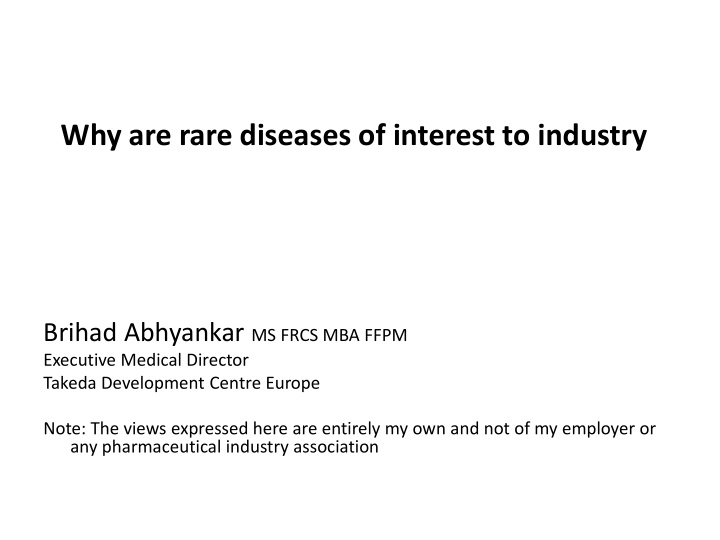



Why are rare diseases of interest to industry Brihad Abhyankar MS FRCS MBA FFPM Executive Medical Director Takeda Development Centre Europe Note: The views expressed here are entirely my own and not of my employer or any pharmaceutical industry association
Environmental • End of ‘blockbuster’ model – Increased pipeline attrition – Increased R&D spending – R&D productivity is becoming challenging • Desire for personalized medicine • Advances in science offering clues to pathophysiology • ‘educated’ patient community
Scientific • Significant advances in understanding of diseases No of conditions designated as rare diseases from 1983 to 2010 200 180 160 140 120 No of conditions designated as rare 100 diseases from 1983 to 2010 80 60 40 20 0
Scientific • Many rare conditions are genetic in origin and therefore manifest early in life. • Industry attempts to address pathology – Re-purpose current product and pursue new indication – Screen novel compounds for activity against rare disease targets • Many phenotypic syndromes or conditions increasingly identified as distinct identified diseases
Regulatory • Regulatory path and incentives from FDA, EMA and others. • Many factors involved. • Higher probability (93%) of regulatory success compared with 88% for non-orphan drugs (p < 0.05). • Phase II to launch timelines – orphan drugs 3.9 years – Non-orphan 5.42 years Meekings KN, et al Orphan drug development : an economically viable strategy for biopharma R&D. Drug Discov Today 2012;17:13-14; 660-664
Commercial • Increasing strategic choice made by some companies to develop new drugs for rare diseases.
Selecting a rare disease for development R&D/ scientific Commercial consideration consideration Understanding of biology Prevalence and pathophysiology Geographic and Availability of clinical and demographic distribution scientific experts Unmet need and available Available treatments patient population
Summary • These are generic perspectives from a clinician in the industry but not from a specialist in ‘rare disease’ development. • Patients with a rare diseases have an equal right to medicines as do other patients with a well-known disease • For many rare diseases there is still no treatment available • But many advances are being made and likely to grow • Industry, Regulators, Scientists and Clinicians need to work even closer together
Recommend
More recommend